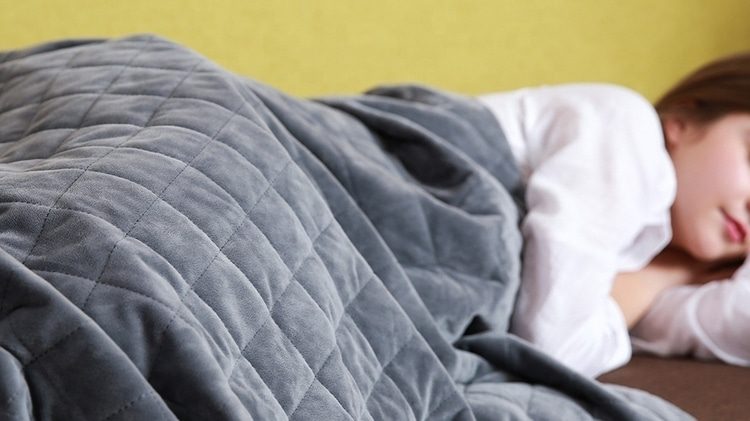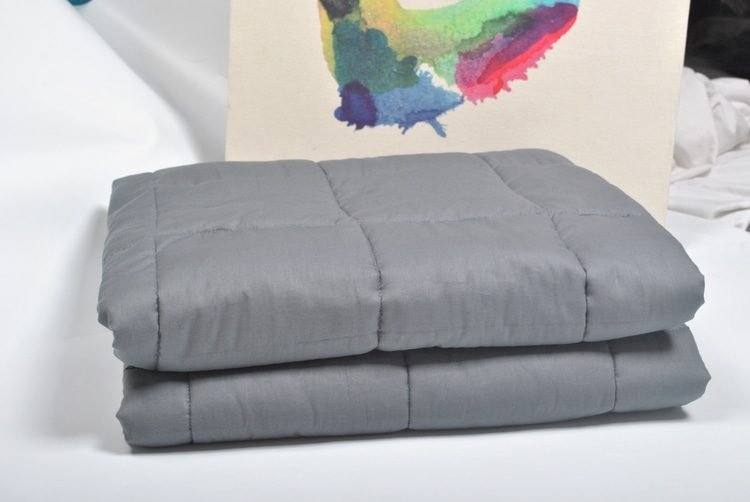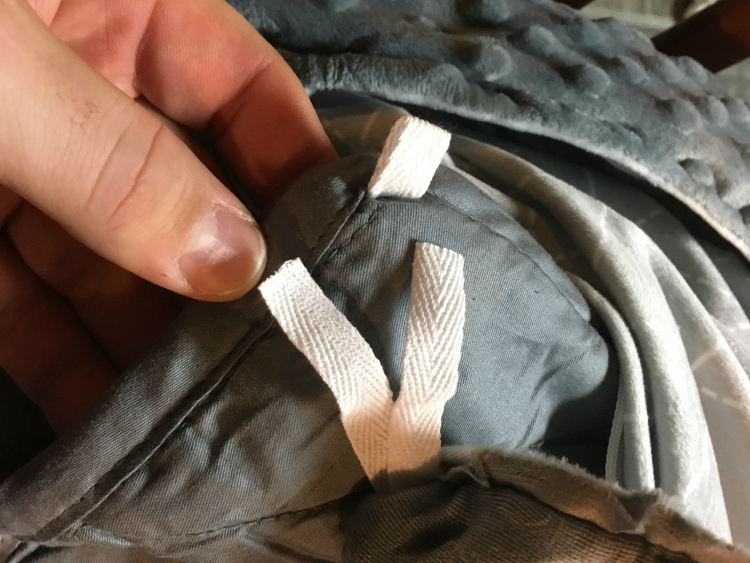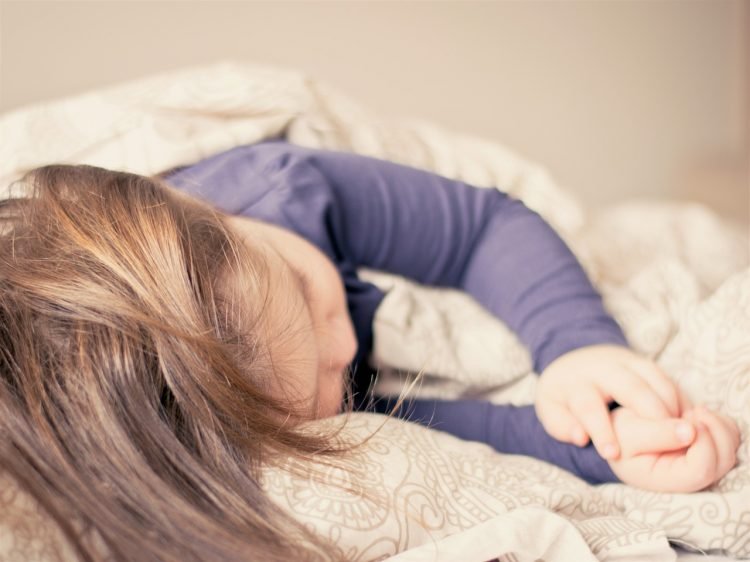Kids love blankets. From the minute they are born we wrap them up in cloth and love to make them feel safe and secure. Many toddlers and preschoolers use blankets or stuffed animals as transitional objects, something they attach to as they begin to detach from constant parental attention.
Kids take favorite blankets along on sleepovers or trips as a way to bring a familiar feel to an unfamiliar sleeping situation. Blankets are so much a part of feeling protected and safe in childhood that even as adults, we call anything we are dependent on a “security blanket”.
Years ago, occupational therapists noticed that some children with certain behavioral disorders sought out heavy weight or pressure to calm themselves. They would crawl under the nap mats instead of lying on top of them or pile pillows on themselves.
Seeing how well it worked for these kids, therapists began to experiment purposely applying with weight as a way to calm very agitated children. In doing so, they also found that kids with milder concentration or anxiety issues were also helped with weighted devices.
Now weighted blankets are on the market for anyone. Is a weighted blanket something that your child might find even more comforting and relaxing than a typical blankie?
What Kinds of Kids Benefit from Weighted Blankets?
Weighted blankets aren’t just for kids with special needs. Any child, or adult, who finds the feeling of weight comforting will benefit from a weighted blanket.
Preferring lots of blankets or sleeping under afghans or heavy quilts, tucking feet under sofa cushions, seeking out small spaces to play, and sitting in boxes or bins are all indications that your child might enjoy the added pressure of a weighted blanket.
People who do like the added weight generally find it calming. That means that for smaller children a weighted blanket can help during travel or other periods away from home, when they need extra security.

Older kids who tend to fidget might find a weighted blanket, or other weighted device helpful when they need to sit still such as during a car or plane ride, at the movies or while doing homework.
Even children without an anxiety disorder feel anxious from time to time and even kids who don’t have ADHD sometimes struggle with paying attention. If weighted blankets help with severe struggles, it makes sense that they would help with milder struggles.
How Do Weighted Blankets Work?
Weighted blankets, like all weighted products, work through deep touch pressure. This kind of touch is felt deep in the body, in the muscles more than the skin, and is calming for most people.
It is the same kind of feeling we get from a hug or massage. Weighted blankets provide a hug your child can seek out and control when he or she most needs it. Occupational therapists have used deep touch pressure on children with autism, sensory disorders and ADHD for years with good results.
They roll the kids up in blankets and mats or roll a ball over their bodies. Special education teachers encourage kids to wear weighted vests or lap pads while working to help with self-regulation and focus.
Deep pressure aids in proprioception, an awareness of where you are and what your body is doing. Without proprioception, kids feel confused and anxious, and with it, they feel more secure. It also helps to provide grounding, a pleasant physical sensation that helps the mind focus on the here and now. Weight provides sensory input constantly, not unexpectedly or erratically.
Finally, deep touch pressure has been shown to increase the release of calming chemicals, and decrease the presence of stress hormones. Blankets and other weighted products are a great way to provide kids with this deep pressure that they can control because their blanket is readily available whenever it is needed.
Children on the Autism Spectrum
If your child is on the autism spectrum, a weighted blanket is ideal. These kids often reject human touch because it is unpredictable, even startling.

But a weighted blanket can be like a hug your child controls. Also, deep pressure is calming, especially for autistic children who react badly to lighter touch on the skin which can be overstimulating. Blankets provide pressure evenly over the entire body, or just on the part of the body that your child personally finds calming.
Even severely autistic kids who struggle to communicate can calm themselves by controlling how much of a “hug” they need and when they need it.
Struggling with Sensory Processing
Children with sensory processing disorder (SPD) have long been treated with weighted products by occupational therapists. These kids are some of the most likely to benefit from weighted products. If your child has SPD, you know that these kids are either under or over sensitive to input from the outside world.
A poor sense of proprioception leaves some kids with SPD feeling untethered and agitated. Others whose sense of smell or hearing is turned up too high feel assaulted by the world around them.
For either type of sensory disorder, a weighted blanket can be comforting. For the child who is too aware of sensory input, heavy pressure from a blanket can be calming. In the same way that a constant background noise tunes out intermittent sounds, constant pressure helps the nervous system tune out all the little annoying sensations.
For children who seek more sensation, heavy pressure gives it to them.
Helping Kids with ADHD Succeed
Weighted vests and lap pads have proven to be successful in the classroom, helping kids with ADHD settle down to learning. Studies have shown longer periods of on-task behavior and increased concentration with the use of weighted vests. Weighted blankets work on the same principle.
One reason for this is that children with ADHD often have at least some sensory processing difficulties as well. In addition, weighted blankets help with focus. Added weight grounds them and minimizes distractions, daydreaming, and wiggling.
Calming Anxiety and Anxiousness
Deep touch pressure increases serotonin and dopamine, the same chemicals that anti-depressants target. It also decreases cortisol, the stress hormone. Weighted blankets are a natural alternative to prescription drugs if you have an anxious child but are concerned about the effects of chemicals on a young brain.
But Are Weighted Blankets Safe?
Weighted blankets are safe, as long as they are used correctly. They are not recommended for a child younger than 3 and should never be used with an infant or anyone unable to move out from under them.
Fatalities have occurred because a weighted blanket was used on an infant, or used as a restraint. Guidelines for a blanket weight of roughly 10% of the child’s body weight exerts a steady pressure, but won’t hold restrain them. A weight heavier than that is not only dangerous due to risk of suffocation should your the be unable to get out from under it, but it is counter-productive to the calming effects the blanket is meant to provide.
Weighted blankets work partially because they are self-regulating and self-applied. When forced on a child, they are no more relaxing than being tied up. Never exceed the weight recommendations of the manufacturer or insist on your child using the blanket.
What to Look for in a Weighted Blanket?
Weighted blankets come in all colors and types of fabric. You can choose a luxurious velvety fabric or one a wonderful variety of cotton prints.
Many of the fuzzy ones come with an optional cotton cover, which is nice for warmer weather, and the cottons have the added advantage of allowing kids to choose a print that excites them visually, whether that is dinosaurs or princesses or turtles.
Nearly all the weighted blankets you find online are washable. Ones with a removable cover allow you to wash just the cover, and wash the blanket itself less often.
Weighted blankets are meant to fit the person, not the bed, so even a twin size may not work as a bed cover. In fact, a smaller one might be useful for taking in the car because it is less to carry and less to wash when it gets dropped in the dirt or covered with ice cream at the drive thru.

Children’s Weight Recommendation
- 5lb (for 40 lb)
- 6lb (for 50 lb)
- 7lb (for 60 lb)
- 8lb (for 70 lb)
- 12lb (for 80-100 lb)
- 14lb (for 110-120 lb)
Other Weighted and Deep Pressure Products
Many studies on the benefits of weight as a therapeutic tool were conducted with weighted vests and they are a great alternative to blankets, especially for kids who need them during the day or at school. One problem with a weighted vest is that some look like medical devices more than clothing and that might be embarrassing.
But with a little extra shopping, you can find a denim vest, or a safari style vest, or even a hoodie for maximum kid style and coolness.
Also helpful during school or homework time is a weighted lap pad. These vary in size and weight, but start at two pounds and come in all kinds of fun prints. Lap pads sit on a child’s lap like a large dinner napkin and help settle the wiggles and squirmies during homework or reading time. They are easier to pack around than a weighted blanket and are popular with occupational therapists. But again, even typical kids sometimes need help to stay calm and concentrate on school work.
Many stuffed animals are partially weighted, but special ones with more weight are available. Older kids might like the animals that look like travel pillows and fit around their necks. Some are even scented with calming herbs and can be heated or cooled for added appeal to the senses. Teens might like to try a weighted heating/cooling pad which is sold to relieve sore muscles but is also weighted so it could help with attention and focus.
Weight isn’t the only way to apply deep pressure. Some kids might also rest better with a stretchy bedsheet which fits on the bed like a giant pillowcase. Once inside, the sheets conform tightly to your child’s body, applying a hug-like pressure. Special stretchy sleeping bags can be used for sleep or just to squirm against as a kind of sensory workout.

